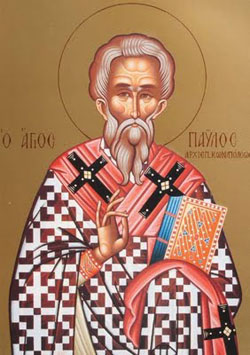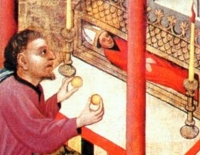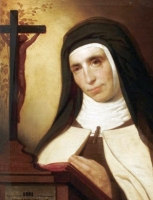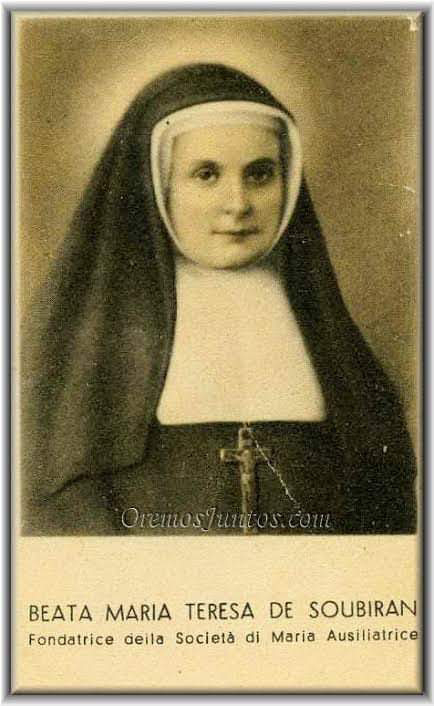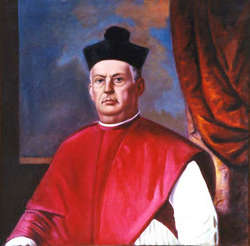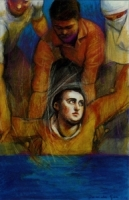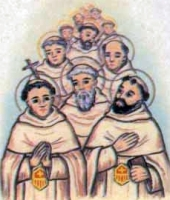St. Vulphy
Feastday: June 7
Death: 643
Hermit and miracle worker, also called Vulfiafius. Originally from Rue, near Abbeville, France. Vulphy was married but received his wife's permission to become a priest. He gave up an active life after a pilgrimage to become a hermit.
St. Willibald
Feastday: June 7
Birth: 700
Death: 786
Bishop and missionary. A native of Wessex, England, he was the brother of Sts. Winebald and Walburga and was related through his mother to the great St. Boniface. After studying in a monastery in Waitham, in Hampshire, he went on a pilgrimage to Rome (c. 722) with his father, who died on the way at Lucca, Italy. Willibald continued on to Rome and then to Jerusalem. Captured by Saracens who thought him a spy, he was eventually released and continued on to all of the holy places and then to Constantinople (modern Istanbul, Turkey), where he visited numerous lauras, monasteries, and hermitages. Upon his return to Italy, he went to Monte Cassino where he stayed for ten years, serving as sacrist, dean, and porter. While on a visit to Rome, he met Pope St. Gregory III (r. 731-741), who sent him to Germany to assist his cousin St. Boniface in his important missionary endeavors. Boniface ordained him in 741 and soon appointed him bishop of Eichstatt, in Franconia. the Site of Willibald's most successful efforts as a missionary. With his brother Winebald, he founded a double monastery at Heidenheim, naming Winebald abbot and his sister Walburga abbess. Willibald served as bishop for some four decades. His Vita is included in the Hodoeporicon (the earliest known English travel book). An account of his journeys in the Holy Land was written by a relative of Willibald and a nun of Heidenheim.
Willibald (Latin: Willibaldus; c. 700 – c.787) was an 8th-century bishop of Eichstätt in Bavaria.
Information about his life is largely drawn from the Hodoeporicon (itinerary) of Willibald, a text written in the 8th century by Huneberc, an Anglo-Saxon nun from Heidenheim am Hahnenkamm who knew Willibald and his brother personally.[1] The text of the Hodoeporicon was dictated to Huneberc by Willibald shortly before he died.
Willibald's father was Richard the Pilgrim, and his mother Wuna of Wessex. His brother was Winibald and his sister was Walburga.[2]
Willibald was well-travelled and the first known Englishman to visit the Holy Land.[3] His shrine is at the Eichstätt Cathedral in Germany, where his body and relics from his journeys are preserved.
His feast day is 7 July.
St. Paul of Constantinople
Feastday: June 7
Death: 350
Bishop of Constantinople, during the period of bitter controversy in the Church over the Arian heresy. Elected in 336 to succeed Alexander of Constantinople, the following year he was exiled to Pontus by Emperor Constantius II. Because of his staunch position against Arianism, Paul was replaced by the heretical bishop Macedonius. Allowed to return in 338, Paul was again exiled by the Arians, who had the support of many in the imperial government, but returned about 340. Once more he was seized and, at the order of Emperor Constantius, he was exiled to Mesopotamia. Brought back in 344, he was sent yet again into exile, this time to Cucusus, inArmenia. Here he was deliberately starved and finally strangled by Arian supporters. He is considered a martyr for the orthodox cause and was a close friend St. Athanasius.
From Menologion of Basil II
Paul I or Paulus I or Saint Paul the Confessor (died c. 350), was the sixth bishop of Constantinople, elected first in 337 AD. Paul became involved in the Arian controversy which drew in the Emperor of the West, Constans, and his counterpart in the East, his brother Constantius II. Paul was installed and deposed three times from the See of Constantinople between 337 and 351. He was murdered by strangulation during his third and final exile in Cappadocia. His feast day is on November 6.
Biography
He was a native of Thessalonica, a presbyter of Constantinople, and secretary to the aged bishop Alexander of Constantinople, his predecessor in the see. Both the city and its inhabitants suffered much during the Arian controversies. No sooner had Alexander breathed his last than the Arian and Orthodox parties came into open conflict. The Orthodox party prevailed; in 337 Paul was elected and consecrated by bishops who happened to be at Constantinople in the Church of Peace, close to what was afterwards the Hagia Sophia.[1]
First exile
The Emperor Constantius II had been away during these events. On his return he was angry at not having been consulted. He summoned a synod of Arian bishops, declared Paul quite unfit for the bishopric, banished him, and transported Eusebius of Nicomedia to Constantinople. This is thought to have been around 339. Paul, seeing himself rendered useless to his flock, while Arianism reigned in the East under the protection of Constantius, took shelter in the West, in the dominions of Constans. He went to Rome where he met Athanasius, who also had been expelled from his see.[2]
Athanasius of Alexandria was then in exile from Alexandria, Marcellus from Ancyra, and Asclepas from Gaza; with them Paul betook himself to Rome and consulted Pope Julius I, who examined their cases severally, found them all staunch to the creed of Nicaea, admitted them to communion, espoused their cause, and wrote strongly to the bishops of the East. Athanasius and Paul recovered their sees; the Eastern bishops replied to Pope Julius altogether declining to act on his advice.[1]
Second exile
Paul returned to Constantinople. Eusebius died in 341, and Paul was reinstated as bishop.[3] The Arians seized the occasion; Theognis of Nicaea, Theodorus of Heraclea, and other heterodox bishops, consecrated bishop Macedonius in the church of St. Paul; and again the city became the prey of a civil war.[1]
The Emperor Constantius was at Antioch when he heard of this, where he ordered Hermogenes, his general of cavalry, to see that Paul was again expelled. The people would not hear of violence being done to their bishop; they rushed upon the house where the general was, set fire to it, killed him on the spot, tied a rope round his feet, pulled him out from the burning building, and dragged him in triumph round the city.[1] Constantius was not likely to pass over this rebellion against his authority. He rode on horseback at full speed to Constantinople, determined to make the people suffer heavily for their revolt. They met him, however, on their knees with tears and entreaties, and he contented himself with depriving them of half their allowance of corn, but ordered Paul to be driven from the city.[1]
Third exile
Paul seems to have retired to Triers, but returned to Constantinople in 344, with letters of recommendation from Constans, the emperor of the West, who wrote to Constantius, that should Paul not receive his patriarchal see, he would attack him. Constantius only allowed Paul's re-establishment for fear of his brother's arms, and Paul's situation in the East continued very uneasy, for he had much to suffer from the power and malice of the Arian party.[3]
Constans died in 350. Constantius, in Antioch, ordered Philippus, prefect of the East, to once more expel Paul and to put Macedonius in his place. At a public bath called Zeuxippus, adjoining a palace by the shore of the Bosphorus, Philippus asked Paul to meet him, as if to discuss some public business. When Paul arrived, he showed him the emperor's letter, and ordered him to be quietly taken through the palace to the waterside, placed on board ship, and carried off to Thessalonica, his native town. Philippus allowed him to visit Illyricum and the remote provinces, but forbade him to set foot again in the East.[1]
Paul was later loaded with chains and taken to Singara in Mesopotamia, then to Emesa, and finally to Cucusus in Cappadocia.[1] Here he was confined in a close, dark place, and left to starve to death. After he had passed six days without food, he was, to the great disappointment of his enemies, found alive. Upon which they strangled him, and gave out that he died after a short sickness.
Paul's body was brought to Ancyra in Galatia, and, by the order of Theodosius the Great, was thence translated to Constantinople in 381, about thirty years after his death. It was buried there in the great church built by Macedonius, which from that time was known by no other name than that of St. Paul. His remains were removed to Venice in 1226, where they are kept with great respect in the church of St. Laurence.
Saint Robert of Newminster
Profile
Studied at the University of Paris. Wrote a commentary on the Psalms, but it has been lost. Parish priest at Gargrave, England, and later a Benedictine monk at Whitby, England. With his abbot's permission, he joined the founders of the Cistercian monastery of Fountains Abbey in 1132. He headed the first Cistercian colony sent from Fountains in 1138. He established the abbey of Newminster near the castle of Ralph de Merlay, one in Morpeth, England, one in Pipewell, England in 1143, one in Roche, Cornwall in 1147, and another in Sawley, Lancashire, England in 1148. Friend of Saint Godric of Finchale. Reputed to have had supernatural gifts, received visions, and suffered encounters with demons.
At least one biography says that Robert was accused by his own monks of sexual misconduct with a local woman, and that he went abroad c.1147-1148, to defend himself before Saint Bernard of Clairvaux. However, there seems little support for this story except the desire by its originator to claim he was acquitted by the great Bernard.
Legend says that he fasted so rigorously during Lent that a brother monk pleaded with him to eat. Robert agreed, and was given some buttered oatcake. But he suddenly feared to commit the sin of gluttony, and asked it be given to the poor. A beautiful stranger at the gate took the cake - and the dish. As a brother was explaining the incident, the dish suddenly appeared on the table before the abbot; the brothers decided the stranger was an angel.
Born
c.1100 at Gargrave, Craven district, Yorkshire county, England
Died
• 7 June 1159 at Newminster England of natural causes
• buried in Newminster, but later entombed in the local church
• Saint Godric of Finchale said that he saw Robert's soul ascend to heaven as a ball of fire
• miracles reported at the tomb
Saint Anthony Mary Gianelli
புனிதர் அன்டோனியோ மரிய கியனேல்லி
(St. Antonio Maria Gianelli)
பிறப்பு : ஏப்ரல் 12, 1789
செரெட்டா, மான்ட்டுவா, மிலன்
(Cereta, Mantua, Duchy of Milan)
இறப்பு : ஜூன் 7, 1846 (வயது 57)
புனிதர் பட்டம் : அக்டோபர் 21, 1951
திருத்தந்தை பன்னிரெண்டாம் பயஸ்
(Pope Pius XII)
நினைவுத் திருநாள்: ஜுன் 07
பாதுகாவல் :
போப்பியோ மறைமாவட்டம் (Diocese of Bobbio), வல் டி வர (Val di Vara)
புனிதர் அன்டோனியோ மரிய கியனேல்லி, இத்தாலியின் ரோமன் கத்தோலிக்க திருச்சபையின் ஆயரும், "தோட்ட அன்னையின் மகள்கள்" (Daughters of Our Lady of the Garden) மற்றும் "புனித அல்போன்சஸ் மறைப்பணியாளர்கள்" (The Missionaries of Saint Alphonsus) ஆகிய சபைகளை நிறுவியவரும் ஆவார்.
கி.பி. 1789ம் ஆண்டு, விவசாயிகளின் கிராமமொன்றில் பிறந்த அன்டோனியோ மரிய கியனேல்லியின் தந்தை பெயர் "கியாகொமோ" (Giacomo) ஆகும். இவரது தாயார் பெயர் "மரிய கியனேல்லி" (Maria Gianelli) ஆகும். ஐந்து சகோதரர்களுடன் பிறந்த இவர் ஒரு விதிவிலக்கான மாணவர் ஆவார். இவரது குடும்பத்தினர் தங்கியிருந்து பணியாற்றிய பண்ணையின் உரிமையாளரே இவரது குருத்துவ படிப்புக்காக செலவு செய்தார்.
1807ம் ஆண்டு, நவம்பர் மாதம், தமது 18 வயதில் "இறையியல் சித்தாந்தம்" மற்றும் "புனித வழிபாட்டு முறை" ஆகியவற்றை கற்க ஆரம்பித்து முனைவர் பட்டம் வென்றார். 1812ம் ஆண்டு, மார்ச் மாதம், "ஜெனோவாவின் கர்தினால் பேராயர்" (Cardinal Archbishop of Genoa) "கியுசெப் மரிய ஸ்பினா" (Giuseppe Maria Spina) அவர்களால் திருத்தொண்டராக அருட்பொழிவு செய்விக்கப்பட்ட இவர், அதே 1812ம் வருடத்திலேயே அதே கர்தினால் பேராயராலேயே குருத்துவ அருட்பொழிவு செய்விக்கப்பட்டார். முறையான வயதாகாத காரணத்தால் இவருக்கு சிறப்பு ஒதுக்கீடு அளிக்கப்பட்டது. குருத்துவம் பெற்ற இவர், "மான்ட்டுவா" (Mantua) என்ற பங்கில் பங்குத்தந்தையாக நியமனம் பெற்று பணியாற்றினார்.
1826ம் ஆண்டு, "சியாவாரியின்" (Chiavari) தலைமை குருவாக நியமிக்கப்பட்டார். 1837ம் ஆண்டு வரை பதினோரு வருடங்கள் அதே பதவியிலிருந்தார். ஆண்களுக்கான "புனித அல்போன்சஸ் மறைப்பணியாளர்கள்" (The Missionaries of Saint Alphonsus) என்ற சபையை 1827ம் ஆண்டு நிறுவினார். அந்த சபை 1848ம் ஆண்டு வரை நீடித்தது. 1829ம் ஆண்டு, ஜனவரி மாதம், 12ம் நாளன்று, "தோட்ட அன்னையின் மகள்கள்" (Daughters of Our Lady of the Garden) என்ற பெண்களுக்கான சபையை நிறுவினார். ஏழைப் பெண்களுக்கு கல்வி கற்பிக்கவும் நோயாளிகளுக்கு சேவை செய்வதற்காகவும் இந்த சபை பணியாற்றுகிறது. இதன் சேவைகள், இன்றும் ஐரோப்பா, ஆசியா மற்றும் ஐக்கிய அமெரிக்க நாடுகள் (Europe, Asia and the United States of America) ஆகிய உலக நாடுகளில் தொடர்ந்து நடைபெறுகிறது. இவர் மரித்து பல வருடங்களின் பின்னர் 1882ம் ஆண்டு, ஜூன் மாதம், 7ம் நாளன்று, திருத்தந்தை பதின்மூன்றாம் லியோ (Pope Leo XIII) இச்சபைக்கு முறையாக அங்கீகாரமளித்தார்.
திருத்தந்தை பதினாறாம் கிரகோரி (Pope Gregory XVI) அவர்கள் இவரை "போப்பியோ" மறைமாவட்ட ஆயராக (Bishop of Bobbio) 1837ம் ஆண்டு, நியமித்தார்.
சுமார் ஒரு வருட காலம் நோய்வாய்ப்பட்டிருந்த இவர், ஜூன் 1846ம் ஆண்டு, ஜூன் மாதம், 7ம் நான்று, மரித்தார்.
Also known as
Antony Gianelli
Profile
Son of Mary and James Gianelli, Anthony grew up in a poor but pious family in a small farming village. His mother taught catechism, and his father was known as a generous peace-maker in the town. Anthony was such a promising student that the owner of his family farm paid for his seminary education. Ordained on 24 May 1812; he was so young that he needed special dispensation for the ordination, but was such a promising candidate that he received it. Served as a parish priest.
Archpriest of Chiavari, Italy in 1826. Founder of the Missionaries of Saint Alphonsus in 1827, a men's missionary congregation that lasted until 1856. Founder of the Oblates of Saint Alphonsus in 1828, which lasted until 1848. Founder of the Sisters of Our Lady of the Garden 1829, a women's teaching order that also worked with the sick, and which continues its work today in Europe, the United States, and Asia. Bishop of Bobbio, Italy in 1837. Organized the Society of Saint Raphael and Society of Saint Dorothea to instruct the faithful in his diocese. Restored devotion to Saint Columbanus in his diocese. Conducted two synods, and was constantly on the road from parish to parish, visiting his flock.
Born
12 April 1789 at Cerreto, Italy
Died
7 June 1846 of a serious fever
Canonized
21 October 1951 by Pope Pius XII
Readings
O Saint Anthony Gianelli, who through your work have shown such great love to all, intercede for the bishops of the world and especially my bishop {name of your bishop}. Help our bishops to spread the Gospel to all men so that through them all men may find the way to salvation. I ask you to intercede on my behalf so that through your powerful intercession I may obtain the grace that I so ardently desire {name your intention}. Intercede for me and for all those who are dear to me peace of mind, perseverance in good works and a holy death. Amen.
Saint Deochar
Also known as
Deocarus, Deotker, Dietger, Gottlief, Theotgar, Theutger
Profile
Hermit in the Franconia forests near Fulda, an area in modern Germany. Spiritual student of Blessed Alcuin at Aachen, Germany. Benedictine monk and first abbot of Herriedon abbey; he was chosen for the position by Blessed Charlemagne. Appointed missus regius (king's messenger), a royal office, in 802. Helped translate the relics to Saint Boniface to Fulda in 819. Attended the synod of Mainz, Germany in 829. A famous miracle ascribed to him was healing a young boy's blindness by prayer.
Born
late 8th century, probably in Bavaria, Germany
Died
• 847 at the abbey of Herriedon, Germany of natural causes
• interred in the church of Saint Vitus
• some relics were moved to Saint Lawrence church, Nuernberg, Germany in 1316
• these relics were moved to Eichstätt, Germany in 1845
Patronage
• blind people
• eye patients
Blessed Anne of Saint Bartholomew
Also known as
• Ana García Manzanas
• Ana of Saint Bartholomew
• Anne Garcia
Profile
Worked as a shepherdess in her youth. Lay Carmelite at age 20 under the direction of Saint Teresa of Avila. Anne became secretary to and close friend of Saint Teresa; Teresa died in Anne's arms. Worked on the Carmelite reform in France. Prioress of houses at Tours and Pontoise. Founded the Carmelite house in Antwerp, Belgium in 1612. Wrote poetry, some of which has survived to today.
Born
1 October 1549 at Almendral, Spain as Anne Garcia
Died
7 June 1626 at Antwerp, Belgium of natural causes
Beatified
6 May 1917 by Pope Benedict XV
Saint Gotteschalk
Also known as
Godescalco, Godescalcus, Godeschalc, Gotteschalc, Gottschalk
Profile
Son of Udo, Prince of the Abrodites. Prince of the Wends. Raised a Christian, he turned apostate following the murder of his father, led armies into lands held by the Slavs, and then into England. There, for reasons never clearly explained, he returned to the faith. On his return from England, he subdued more of the Slavic countries, and went on period a great missionary work and church construction. Gottschalk often interpreted to the people in the Sclavonian tongue the sermons and instructions of the priests in the church, which led to his patronage of linguists and translators. Martyr.
Died
murdered at the altar with 29 fellow missionaries on 7 June 1066 in Lenzen, Pomerania, by assassins hired by his brother-in-law
Patronage
• linguists
• lost vocations
• princes
• translators
Saint Colman of Dromore
Also known as
• Colman of Llangolman
• Colmoc, Mocholmoc, Mocholmog
Additional Memorials
• 20 November (Llangolman, Wales)
• 6 June (Aberdeen Breviary)
Profile
Knew Saint Patrick. Studied at Noendrum under Saint Mochae of Noendrum, and then under Saint Ailbe of Emly. First abbot of Muckmore Abbey, County Antrim, Ireland. Founding abbot-bishop of the diocese of Dromore, County Down, Ireland c.514. Taught Saint Finnian of Clonard. Friend and advisor to Saint Macanisius. Miracle worker.
Born
Argyllshire, Dalriada (in modern Scotland)
Died
c.585 of natural causes
Canonized
1903 (cultus confirmed)
Patronage
diocese of Dromore, Ireland
Saint Meriadoc of Vannes
Also known as
Meredith, Meriadec, Meriasek, Meryasek
Profile
Wealthy 6th-7th century lord of a large manor, he sold it off and gave the procedes to the poor. Hermit at Rohan, Brittany, France. Ordained by Saint Hingueten. Bishop of Vannes, France in 666. Subject of a wholly fictional medieval play in vernacular Cornish. Legend says that a bell from his church in Stival in Brittany would cure deafness and migraines if placed against the head of the sufferer.
Born
Welsh
Patronage
• against deafness
• against migraines
• Cambourne, Cornwall, England
Saint Wallabonsus of Cordoba
Also known as
Wallabonso
Profile
His mother was a Christan convert from Islam; his sister Maria became a nun. Educated at the monastery of Saint Felix. Deacon in Moorish-occupied Cordoba, Spain, working with Saint Peter. Martyred in the persecutions of Abderrahman for denouncing Mohammed.
Born
Elepha (modern Niebla), Huelva, Spain
Died
• beheaded on 7 June 851 at Cordoba, Spain
• body put on display for public abuse, then burned and ashes dumped in the Guadalquivir river
Saint Jeremiah of Cordoba
Also known as
Geremia, Jeremias
Profile
As a very old man, Jeremiah founded the double-monastery of Tábanos in Moorish-occupied Cordoba, Spain, and became a monk there; his wife, Elizabeth, became a nun in the female wing. Martyred in the persecutions of Abderrahman for denouncing Mohammed.
Born
Cordoba, Spain
Died
• scourged to death on 7 June 851 at Cordoba, Spain
• body put on display for public abuse, then burned and ashes dumped in the Guadalquivir river
Saint Landulf of Yariglia
Also known as
Landulf of Asti
Profile
Studied at the Benedictine monastery of San Pietro in Ciel d'Oro in Pavia, Italy. Priest. Canon of Milan, Italy. Bishop of Asti, Italy in 1105, a position that included the civil government of the city.
Born
the latter 11th century at Vergiate, Milan, Italy
Died
• c.1133
• interred in a marble sarcophagus
• relics moved to the altar of the chapel of Saint Agnes at the cathedral of Asti, Italy some point soon after 1450
Blessed Basilissa Fernandez
Profile
Premonstratensian nun at the monastery of Santa Sofia Toro in Zamora, Spain, making her vows on 13 October 1867. Secretary to her abbess, she maintained the correspondence with all other Premonstratensian houses. wrote several articles and pamphlets to support the work of Messe Réparatrice and the Sodality of Saint Peter Claver. Known for her dedication to Eucharistic Adoration.
Born
15 April 1845 in Tiedra, Valladolid, Castilla y Leon, Spain
Died
7 June 1907
Saint Wistremundus of Cordoba
Also known as
Wistremundo
Profile
Monk at the monastery of Saint Zoilus in Moorish-occupied Cordoba, Spain. Martyred in the persecutions of Abderrahman for denouncing Mohammed.
Born
Froniano, Spain
Died
• beheaded on 7 June 851 at Cordoba, Spain
• body put on display for public abuse, then burned and ashes dumped in the Guadalquivir river
Saint Sabinian of Cordoba
Also known as
Sabiniano, Sabinianus
Profile
Monk at the monastery of Saint Zoilus in Moorish-occupied Cordoba, Spain. Martyred in the persecutions of Abderrahman for denouncing Mohammed.
Born
Froniano, Spain
Died
• beheaded on 7 June 851 at Cordoba, Spain
• body put on display for public abuse, then burned and ashes dumped in the Guadalquivir river
Blessed Demosthenes Ranzi
Profile
Graduated with a law degree from the University of Turin, Italy. Joined the Franciscans in 1477 at the convent of Santa Maria degli Angeli in Turin. A noted preacher, in 1497 he was given a commission by Pope Alexander VI to preach against Waldensianism.
Born
Vercelli, Italy
Died
1512 in the convent of Santa Maria degli Angeli Turin, Italy of natural causes
Saint Habentius of Cordoba
Also known as
Abenzio, Abenzo
Profile
Monk at the monastery of Saint Christopher in Moorish-occupied Cordoba, Spain. Martyred in the persecutions of Abderrahman for denouncing Mohammed.
Died
• beheaded on 7 June 851 at Cordoba, Spain
• body put on display for public abuse, then burned and ashes dumped in the Guadalquivir river
Saint Meriadoc II of Vannes
Profile
Priest. Hermit. Meriadoc's reputation for holiness spread, and he was chosen reluctant bishop of in Brittany (in modern France). He hated to give up his life of solitude, but was a good shepherd to his people, especially noted for his charity to the poor.
Born
Brittany (part of modern France)
Died
1302
Saint Peter of Cordoba
Profile
Priest in Moorish-occupied Cordoba, Spain. Martyred in the persecutions of Abderrahman for denouncing Mohammed.
Born
Astigi (modern Ecija), Seville, Spain
Died
• beheaded on 7 June 851 at Cordoba, Spain
• body put on display for public abuse, then burned and ashes dumped in the Guadalquivir river
Saint Aventinus of Larboust
Profile
Hermit in the Larboust valley in the Pyrenees, part of the border region between modern France and Spain. Martyred by Saracens.
Born
in Bagnères in the Pyrenees mountains in France
Died
732 in the valley of Larboust
Saint Vulflagius of Abbeville
Also known as
Vulfiafius, Vulphy, Wulflagius
Profile
Priest who lived as a hermit near Abbeville, France. Greatly venerated in Montreuil-sur-Mer, France.
Died
c.643 of natural causes near Abbeville, France
Saint Lycarion of Egypt
Also known as
Licarion
Profile
Tortured extensively and executed for his faith. Martyr.
Born
Egypt
Died
beheaded with a sword in Egypt, exact date and location lost
Saint Potamiaena of Alexandria the Younger
Profile
Young Christian girl martyred in the persecutions of Diocletian.
Died
c.304 in Alexandria, Egypt
Saint Justus of Condat
Profile
6th-century Benedictine monk in France.
Died
Condat, France
Canonized
9 December 1903 by Pope Pius X (cultus confirmation)
Saint Odo of Massay
Profile
Benedictine monk. Abbot at Massay the last 32 years of his life.
Died
967 of natural causes
Saint Quirinus of Cluny
Profile
Martyr.
Saint Sergius of Cluny
Profile
Martyr.
Martyrs of Africa
Profile
A group of seven Christians who were martyred together. No details about them have survived except the names – Donata, Evasius, Guirillus, Januaria, Privata, Spisinna, Victurus
Died
unknown location in Africa, date unknown
புனித மரிய தெரேசியா டி சோபிரான் (St. Maria Theresia de Soubiran)
சபை நிறுவுனர்
பிறப்பு
1834
காஷ்டல்நாடரி(Castelnaudary)
இறப்பு
7 ஜூன் 1889
முக்திபேறுபட்டம்: 1946, திருத்தந்தை 12 ஆம் பயஸ்
இவர் தனது 21 ஆம் வயதிலிருந்து அன்னைமரியிடம் கற்பு என்னும் வார்த்தைப்பாட்டை அர்ப்பணித்து துறவற வாழ்வை வாழ்ந்தார். தன்னுடன் 14 இளம் பெண்களையும் சேர்த்து அனைவரும் ஒரே குழுமமாக வாழ்ந்து வந்தனர். பின்னர் இக்குழுவை நாளடைவில் பல இளம் பெண்கள் இனங்கண்டு கொண்டு, தங்களையும் அக்குழுவோடு இணைத்தார். இளம் பெண்களின் எண்ணிக்கை அதிகரிக்கவே, மரிய தெரேசியா டி சோபிரான், தன் பிறந்த ஊரிலேயே ஒரு துறவற இல்லம் தொடங்கினார். இவ்வில்லத்தை இயேசு சபையை சார்ந்த அருட்தந்தை மரியா அக்சீலியாடிஸ் (Maria Auxiliatrice) என்பவர் உதவிசெய்து, ஆன்ம குருவாக பணியாற்றி வழிநடத்திவந்தார். இவர்கள் அனைவரும் ஒன்றாக இணைந்து ஜெபித்து, அன்னையின் அருளால் "மரியன்னையின் உதவியாளர்கள்"(Mariens von der immer währenden Hilfe) என்று தங்களின் சபைக்கு பெயர் சூட்டினர்.
இச்சபையினர் தேவையில் இருக்கும் மனிதர்களை இனங்கண்டு, ஏழைகளைத் தேடி சென்று உதவி செய்து வந்தனர். இவர்களின் பணி சிறக்கவே 1868 ஆம் ஆண்டு திருத்தந்தை 9 ஆம் பயஸ் அவர்களால், முறையான துறவற சபையாக அங்கீகரிக்கப்பட்டது. இதன்பின் தன் 34 ஆம் வயதில் அச்சபையின் முதல் சபைத்தலைவியாக மரிய தெரேசியா டி சோபிரான் அவர்கள் பொறுப்பேற்று வழிநடத்தினார். அதன்பின் பல அவதூறுகளுக்கும், துன்பங்களுக்கும் ஆளாக்கப்பட்டு, பல்வேறு துன்பங்களை அனுபவித்தார். இதனால் 1873 ஆம் ஆண்டு சபைத்தலைவி பதவியிலிருந்து தானே முன்வந்து விலகினார். அதன்பின் அச்சபையை விட்டே வெளியேற வேண்டிய கட்டாயம் ஏற்பட்டது. இதனால் அச்சபையிலிருந்து வெளியேறி "இயேசுவின் இறை இரக்கத்தின் கன்னியர்கள்"(Barmherzigen Sisters) என்ற சபையில் சேர்ந்து, தான் இறக்கும்வரை அங்கேயே தன் வாழ்நாட்களை கழித்தார்.
Sophie-Thérèse de Soubiran La Louvière French pronunciation: [maʁi teʁɛz d subiʁã la luvjɛʁ] (16 May 1834 - 7 June 1893) was a French Roman Catholic nun who established the Sisters of Marie-Auxiliatrice. She adopted the name of Marie of the Sacred Heart in 1877 after she had become a nun.
Pope Pius XII beatified her on 20 October 1946 after the recognition of two miracles found to have been attributed to her intercession.[1]
Life
Sophie-Thérèse de Soubiran La Louvière was born in 1834 in France to Joseph Paul Comte de Soubiran and Noemi de Gélis. She received her First Communion on 29 June 1845.
At the age of 20 she renounced her plans to become a Carmelite nun in order to achieve the aims that her priest uncle Louis de Soubiran had set out for his parish. She attended a retreat under the Jesuit Paul Ginhac and decided to establish her own religious institution in 1864 with a focus on girls. Pope Pius IX - on 19 December 1868 - issued a Decree of Praise for the new order.
Trouble began in 1869, the year after the community was authorized, with the profession of a new sister, who claimed to be a widow. Louvière trained her to keep the books of the order. In 1870 she fled to London due to the Franco-Prussian War and returned home after the Treaty of Frankfurt in May 1871. When she returned, she found herself accused of financial mismanagement by the new sister, with evidence out of the books. As a result, Louvière was forced to leave the community. It took a few years for her to find a community that would accept her; to support herself in the meantime, she took in embroidery. Finally, she was accepted by the Paris monastery of Our Lady of Charity in 1874, where she took vows three years later under the name Marie of the Sacred Heart.
Her health began to take a steep decline after 1881 and she taught at various places in France. Despite the pain she endured she continued to teach catechism to people. She died on 7 June 1889 with her last words being: "Come, Lord Jesus, come!"[1]
Two years later, a new Mary Help of Christians superior reviewed the allegations, as Louvière's book-keeping nemesis had fled the convent, and her husband had come looking for her. As a result of the subsequent examination, it was discovered that the fled book-keeper had embezzled monies of the order, and falsified the books so as to throw the blame on Louvière. The founder was vindicated, and her reputation was restored.
Sainthood
The beatification process started in Paris on 9 May 1934 under Pope Pius XI which granted her the title of Servant of God. The two processes that ensured were ratified in a decree on 22 March 1938. Pope Pius XII conferred upon her the title of Venerable on 7 August 1940 after the recognition of her life of heroic virtue.
Two miracles attributed to her were approved in 1945 and Pius XII beatified her on 20 October 1946.

